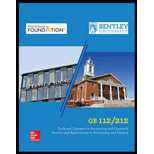
Concept explainers
Recording and Reporting a
Casilda Company uses the aging approach to estimate bad debt expense. The ending balance of each account receivable is aged on the basis of three time periods as follows: (I ) not yet due, $50,000; (2) up to 180 days past due. $14,000; and (3) more than 180 days past due, $4,000. Experience has shown that for each age group, the average loss rate on the amount of the receivables at year-end due to uncollectibility is (1) 3 percent, (2) 12 percent, and (3) 30 percent, respectively. At December 31. the end of the current year, the Allowance for Doubtful Accounts balance is $200 (credit) before the end-of-period
Required:
- 1. Prepare the appropriate bad debt expense adjusting entry for the current year.
- 2. Show how the various accounts related to
accounts receivable should be shown on the December 31, current year,balance sheet .
Want to see the full answer?
Check out a sample textbook solution
Chapter 6 Solutions
GB 112/212 MANAGERIAL ACC. W/ACCESS >C<
- I need help finding the accurate solution to this financial accounting problem with valid methods.arrow_forwardWhat was sales revenue for the year?arrow_forwardA regional savings bank negotiates the purchase of a one-year interest rate cap with a cap rate of 3.85 percent with a large financial institution. The option has a notional principal of 2.2 million and costs 3,400. In one year, interest rates are 4.95 percent. The regional savings bank's net profit, ignoring commissions and taxes, was_.arrow_forward
 Cornerstones of Financial AccountingAccountingISBN:9781337690881Author:Jay Rich, Jeff JonesPublisher:Cengage LearningPrinciples of Accounting Volume 1AccountingISBN:9781947172685Author:OpenStaxPublisher:OpenStax College
Cornerstones of Financial AccountingAccountingISBN:9781337690881Author:Jay Rich, Jeff JonesPublisher:Cengage LearningPrinciples of Accounting Volume 1AccountingISBN:9781947172685Author:OpenStaxPublisher:OpenStax College Financial And Managerial AccountingAccountingISBN:9781337902663Author:WARREN, Carl S.Publisher:Cengage Learning,
Financial And Managerial AccountingAccountingISBN:9781337902663Author:WARREN, Carl S.Publisher:Cengage Learning, Intermediate Accounting: Reporting And AnalysisAccountingISBN:9781337788281Author:James M. Wahlen, Jefferson P. Jones, Donald PagachPublisher:Cengage Learning
Intermediate Accounting: Reporting And AnalysisAccountingISBN:9781337788281Author:James M. Wahlen, Jefferson P. Jones, Donald PagachPublisher:Cengage Learning Financial Accounting: The Impact on Decision Make...AccountingISBN:9781305654174Author:Gary A. Porter, Curtis L. NortonPublisher:Cengage Learning
Financial Accounting: The Impact on Decision Make...AccountingISBN:9781305654174Author:Gary A. Porter, Curtis L. NortonPublisher:Cengage Learning





